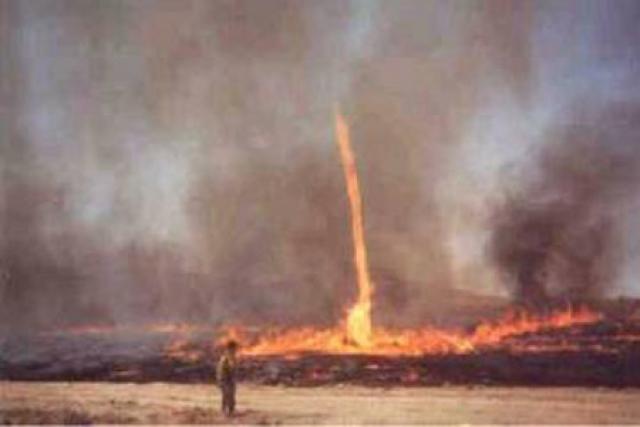
Definition
Fire whirls, also known as fire devils, fire tornadoes or firenadoes, are whirlwinds of flame that may occur when intense heat and turbulent wind conditions combine to form whirling eddies of air. These eddies can tighten into a tornado-like structure that sucks in burning debris and combustible gases.Formation
Combustible, carbon-rich gases released by burning vegetation on the ground are fuel for most fire tornadoes. When sucked up by a whirl of air, this unburned gas travels up the core until it reaches a region where there is enough fresh, heated oxygen to set it ablaze. This causes the tall and skinny appearance of a fire tornado's core.A fire tornado consists of a core—the part that is actually on fire—and an invisible pocket of rotating air that feeds fresh oxygen to the core. The core of a typical fire tornado is 1 to 3 feet (0.30 to 0.91 m) wide and 50 to 100 feet (15 to 30 m) tall. Under the right conditions, large fire tornadoes—several tens of feet wide and more than 1,000 feet (300 m) tall—can form. The temperature inside the core of a fire tornado can reach up to 2,000 °F (1,090 °C)—hot enough to potentially reignite ashes sucked up from the ground. Often, fire tornadoes are created when a wildfire or firestorm creates its own wind, which can turn into a spinning vortex of flame.
Real-world fire whirls usually move fairly slowly. Fire tornadoes can set objects in their paths ablaze and can hurl burning debris out into their surroundings. The winds generated by a fire tornado can also be dangerous. Large fire tornadoes can create wind speeds of more than 100 miles per hour (160 km/h)—strong enough to knock down trees.
Fire tornadoes can last for an hour or more, and they cannot be extinguished directly.
Examples
The Great Peshtigo Fire grew into a firestorm which probably made one or several true tornadoes. Roofs were torn off the houses; even railway wagons were tossed around.
Another extreme example of a fire tornado from other than a vegetation fire is the 1923 Great Kantō earthquake in Japan which ignited a large city-sized firestorm and produced a gigantic fire whirl that killed 38,000 in fifteen minutes in the Hifukusho-Ato region of Tokyo. Survivors' accounts of the nuclear bombing of Hiroshima also describe powerful fire whirls of tornadic proportions during the firestorm that followed the bombing.
Another example is the numerous large fire whirls (some tornadic) that developed after lightning struck an oil storage facility near San Luis Obispo, California on 7 April 1926, several of which produced significant structural damage well away from the fire, killing two. Thousands of whirlwinds were produced by the four-day-long firestorm coincident with conditions that produced severe thunderstorms, in which the larger fire whirls carried debris 5 kilometers away.
Classification
There are currently three known types of fire whirls:
- Type 1: Stable and centered over burning area.
- Type 2: Stable or transient, downwind of burning area.
- Type 3: Steady or transient, centered over an open area adjacent to an asymmetric burning area with wind.
There is evidence suggesting that the fire whirl in the Hifukusho-ato area, during the Great Kanto Earthquake of 1923, was of type 3.
External links
- http://vimeo.com/alicespringsfilmtv/skyfire/ Fire tornado video (whirl) 11 September 2012 Alice Springs Australia.
- Photo
- www.abc.net.au/news Australian researchers document world-first fire tornado.
- Catalyst story: Fire Tornado
- Another photo
- www.youtube.com Video of a Fire whirl (0:30), Brazil.
- "Rare Footage of Fire Tornado". BBC. 25 Aug 2010.
From Wikipedia, the free encyclopedia

No comments:
Post a Comment